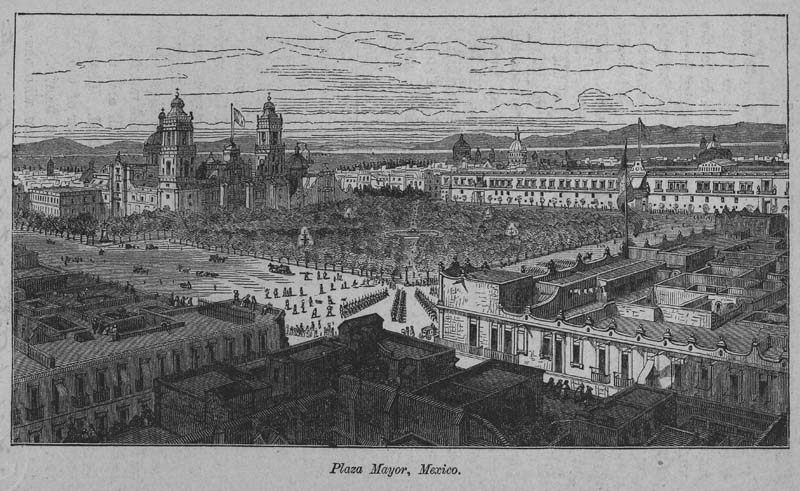On January 11, 1847, vice president Valentin Gómez Farías, in his capacity as acting chief executive in the absence of Santa Anna, who was commanding Mexican forces in the North, signed legislation authorizing the government to requisition up to fifteen million pesos worth of Church property. Intended to help finance the war against the United States, the forced loan -- a sum equivalent to roughly ten percent of Church assets -- immediately drew harsh criticism and calls for repeal from the pro-Catholic press and ecclesiastical authorities. It also faced stout resistance from large landowners and other business leaders who had long used the Church as a source of capital development, since the January 11 law would have required the Church to call in its outstanding loans. Dissatisfaction flared into open rebellion when Gómez Farías ordered National Guard units in Mexico City, which were openly hostile to his policies, to Veracruz to aid in the war effort.
On the evening of February 26, five National Guard regiments rose up in revolt, led by General Matías Peña y Barragán and supported by other prominent moderates, including generals Jose Mariano Salas and Pedro Maria Anaya. The coup's ringleaders issued a thirteen article plan calling for the resignation of Santa Anna and Gómez Farías, and declaring null and void the anti-clerical January law. The uncovering of secret memoranda by historians would later reveal that two prominent clerics, Jorge Madrigal and Vicente Pozo, had funded the revolt, giving 90,000 pesos to Peña y Barragán to distribute to the rebels. Drawn from the ranks of the urban aristocracy, the five National Guard units were the sons of doctors, lawyers and merchants. The rebels were known by their enemies as polkos, a name that seems to have derived from the polka dance, which was popular in elite society. The term also called into question their patriotism by suggesting that their actions were aiding the U.S. President, James K. Polk.
Rejecting an offer of amnesty from Gómez Farías on the second day of the revolt, the rebels took control of several church buildings in Mexico City, while the government's forces controlled the National Palace, the cathedral, and the university. After ten days of street fighting, the rebels reduced their demands to only one: the removal of Gómez Farías from office. On March 11, as U.S. forces began their amphibious landing at Vera Cruz, Santa Anna publicly denounced the rebels and sent 4,000 troops to the capital to restore order. However, upon his return to Mexico City after the battle of Buena Vista, the general forged a peace settlement with the rebel leaders. Congress abolished the office of vice president, effectively removing Gómez Farías from office, and named Anaya "substitute president." Santa Anna also agreed to the repeal of the January 11 law in exchange for a donation of 1.5 million pesos from the Church to fund the war effort.
The revolt revealed the high degree of influence which the Catholic Church continued to enjoy in the young republic, despite liberal efforts to curtail its power. Furthermore, it exposed long-standing rifts among Mexico's political elites, which remained intact even in the face of foreign invasion, at a time when unity was needed most.
Nate Kogan
Bibliography
Conway, Christopher, and Gustavo Pellon. The U.S.-Mexican War: A Binational Reader. Hackett Publishing, 2010, 116.
Costeloe, Michael P. "The Mexican Church and the Rebellion of the Polkos." The Hispanic American Historical Review 46, no. 2 (May 1, 1966): 170-178.
Frazier, Donald. The United States and Mexico at War: Nineteenth-Century Expansionism and Conflict. New York: Macmillan Reference USA, 1998, 329.
Heidler, David Stephen, and Jeanne T. Heidler. The Mexican War. Greenwood Publishing Group, 2006, 113-115.
Howe, Daniel Walker. What Hath God Wrought: The Transformation of America, 1815-1848. New York: Oxford University Press US, 2007, 781-782.
MacLachlan, Colin M., and William H. Beezley. Mexico's Crucial Century, 1810-1910: An Introduction. Lincoln, NE: University of Nebraska Press, 2011, 62-74.
Santoni, Pedro. Mexicans at Arms: Puro Federalists and the Politics of War, 1845-1848. Fort Worth: Texas Christian University Press, 1996, 182-195.

